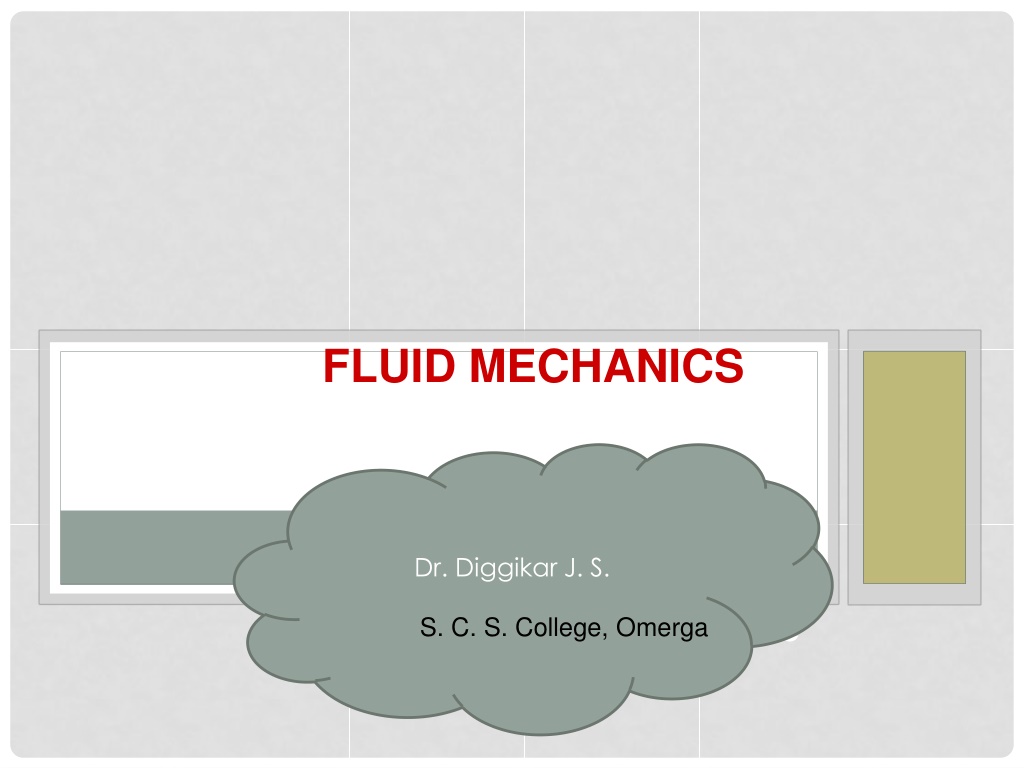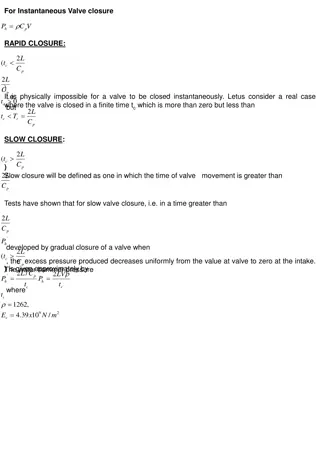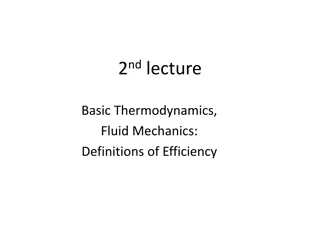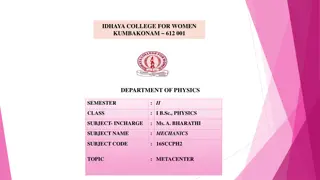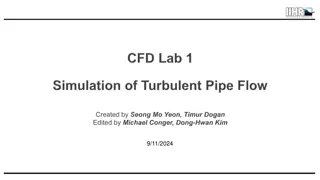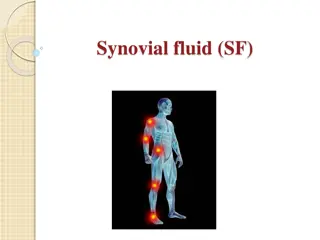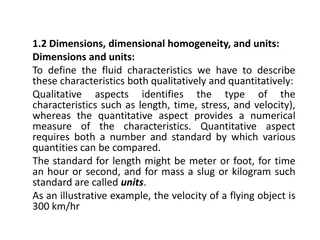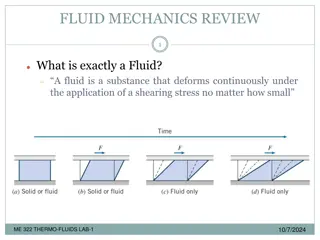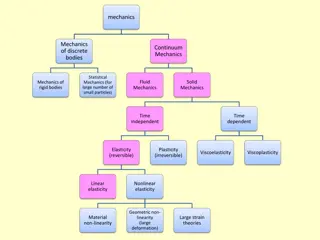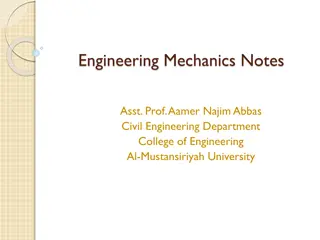Understanding Fluid Mechanics: Fundamentals and Concepts
Fluid mechanics, presented by Dr. Diggikar J. S. and Terri McMurray, delves into the properties of fluids, such as density and pressure, and explains how pressure changes with depth in a static fluid. Learn about ideal fluids, density calculations, pressure measurements, and the distinction between gauge pressure and absolute pressure in this insightful exploration of fluid dynamics.
Download Presentation

Please find below an Image/Link to download the presentation.
The content on the website is provided AS IS for your information and personal use only. It may not be sold, licensed, or shared on other websites without obtaining consent from the author. Download presentation by click this link. If you encounter any issues during the download, it is possible that the publisher has removed the file from their server.
E N D
Presentation Transcript
FLUID MECHANICS Presented by: Dr. Diggikar J. S. Terri McMurray Special thanks to Dolores Gende S. C. S. College, Omerga
FLUIDS A fluid is any substance that flows and conforms to the boundaries of its container. A fluid could be a gas or a liquid. An ideal fluid is assumed to be incompressible (so that its density does not change), to flow at a steady rate, to be non-viscous (no friction between the fluid and the container through which it is flowing), and to flow without rotation (no swirls or eddies).
DENSITY The density ( ) of a substance is defined as the quantity of mass (m) per unit volume (V): =m V For solids and liquids, the density is usually expressed in (g/cm3) or (kg/m3). The density of gases is usually expressed in (g/l).
PRESSURE Any fluid can exert a force perpendicular to its surface on the walls of its container. The force is described in terms of the pressure it exerts, or force per unit area: F A = P Units: N/m2 or Pascal(Pa) One atmosphere (atm) is the average pressure exerted by the earth s atmosphere at sea level 1.00 atm = 1.01 x105 N/m2 = 101.3 kPa
PRESSURE IN FLUIDS A static (non-moving) fluid produces a pressure within itself due to its own weight. This pressure increases with depth below the surface of the fluid. Consider a container of water with the surface exposed to the earth s atmosphere:
PRESSURE IN FLUIDS The pressure P1on the surface of the water is 1 atm. If we go down to a depth from the surface, the pressure becomes greater by the product of the density of the water the acceleration due to gravity g, and the depth h. Thus the pressure P2 at this depth is: P2 = P1 + g h
Note that the pressure at any depth does not depend on the shape of the container, but rather only on the pressure at some reference level and the vertical distance below that level.
GAUGE PRESSURE AND ABSOLUTE PRESSURE Ordinary pressure gauges measure the difference in pressure between an unknown pressure and atmospheric pressure. The pressure measured is called the gauge pressure and the unknown pressure is referred to as the absolute pressure. Pabs = Pgauge + Patm P = Pabs - Patm
PASCAL'S PRINCIPLE Pascal s Principle states that pressure applied to a confined fluid is transmitted throughout the fluid and acts in all directions.
The principle means that if the pressure on any part of a confined fluid is changed, then the pressure on every other part of the fluid must be changed by the same amount. This principle is basic to all hydraulic systems. Pout = Pin
BUOYANCY AND ARCHIMEDES' PRINCIPLE Archimedes Principle states that a body wholly or partly immersed in a fluid is buoyed up by a force equal to the weight of the fluid it displaces. An object lowered into a fluid appears to lose weight. The force that causes this apparent loss of weight is referred to as the buoyant force. The buoyant force is considered to be acting upward through the center of gravity of the displaced fluid. http://images.google.com/images?q=tbn:4md4Qs5jN1IC:express.howstuffworks.com/graphics/neatstuff/sub/archimedes.gif FB = mFg = F g VF
FLUIDS IN MOTION The equations that follow are applied when a moving fluid exhibits streamline flow. Streamline flow assumes that as each particle in the fluid passes a certain point it follows the same path as the particles that preceded it. There is no loss of energy due to internal friction (viscosity) in the fluid. In reality, particles in a fluid exhibit turbulent flow, which is the irregular movement of particles in a fluid and results in loss of energy due to internal friction in the fluid. Turbulent flow tends to increase as the velocity of a fluid increases.
Laminar flow is characterized by streamlines that do not cross. Turbulent flow always is accompanied by many eddies (whirlpool-like circles).
FLOW RATE Consider a fluid flowing through a tapered pipe:
The flow rate is the mass of fluid that passes a point per unit time: m V t t Ah t = = = Av Where is the density of the fluid, A is the cross-sectional area of the tube and v is the velocity of the fluid at the point.
Since fluid cannot accumulate at any point, the flow rate is constant. This is expressed as the equation of continuity. A v = constant In streamline flow, the fluid is considered to be incompressible and the density is the same throughout A1 v1= A2 v2 The equation of continuity can then be written in terms of the volume rate of flow (R) that is constant throughout the fluid: R = Av = constant Units: m3/s or A1 v1 = A2 v2
BERNOULLIS EQUATION In the absence of friction or other non- conservative forces,the total mechanical energy of a system remains constant, that is, PE1 + K1 = PE2 + K2 1 1 + = + 2 2 mgy mv mgy mv 1 1 2 2 2 2
There is a similar law in the study of fluid flow, called Bernoulli s principle, which states that the total pressure of a fluid along any tube of flow remains constant. Consider a tube in which one end is at a height y1 and the other end is at a height y2:
This equation states that: - the sum of the pressures at the surface of the tube, - PLUS the dynamic pressure caused by the flow of the fluid, - PLUS the static pressure of the fluid due to its height above a reference level remains constant.
Find the velocity of a liquid flowing out of a spigot: The pressure is the same P1=P2 The velocity v2= 0 Bernoulli s equation is: This is called Torricelli s Theorem.
1. The pipe shown in the figure has a diameter of 16 cm at section 1 and 10 cm at section 2. At section 1 the pressure is 200 kPa. Point 2 is 6.0 m higher than point 1. When oil of density 800 kg/m3 flows at a rate of 0.030 m3/s, find the pressure at point 2 if viscous effects are negligible. v1 A1 = v2 A2 = R 0.03 (0.08) R A = = v = 1.49 m/s 1 2 1 = 800 kg/m3 r1 = 0.08 m r2 = 0.05 m P1 = 2x105 Pa h1 = 0 m h2 = 6 m R = 0.030 m3/s 0.03 (0.05) R A = = v = 3.82 m/s 2 2 2
1 2 1 2 + + = + + 2 1 2 2 P v gh P v gh 1 1 2 2 1 2 = + + 2 1 2 2 ( ) ( ) P P v v g h h 2 1 1 2 = 2x105 + (800)(1.492 - 3.822) + 800 (9.8) (0-6) = 1.48x105 Pa
2003B6. A diver descends from a salvage ship to the ocean floor at a depth of 35 m below the surface. The density of ocean water is 1.025 x 103 kg/m3. a. Calculate the gauge pressure on the diver on the ocean floor. G P gh = = 3 2 = 3.5 x 105 Pa 1025 kg/m (9.8 m/s ) (35 m) b. Calculate the absolute pressure on the diver on the ocean floor. P P P = + ABS G ATM = 3.5 10 Pa 1.0 10 Pa + 5 5 = 4.5 x 105 Pa
The diver finds a rectangular aluminum plate having dimensions 1.0 m x 2.0 m x 0.03 m. A hoisting cable is lowered from the ship and the diver connects it to the plate. The density of aluminum is 2.7 x 103 kg/m3. Ignore the effects of viscosity. c. Calculate the tension in the cable if it lifts the plate upward at a slow, constant velocity. FT V = 1.0 m x 2.0 m x 0.03 m = 0.06 m3 = = + = 0 F F F F FB T B V G = lg F F F gV T G B A f FG = (2700 1025) kg/m 2 3 3 (9.8 m/s ) (0.06 m ) = 985 N
d. Will the tension in the hoisting cable increase, decrease, or remain the same if the plate accelerates upward at 0.05 m/s2? _____increase Explain your reasoning. _____decrease _____remain the same + = = + F F F ma F F ma F T B G T B G
